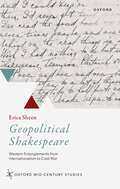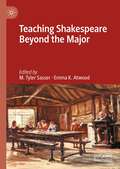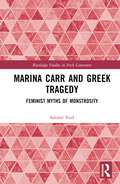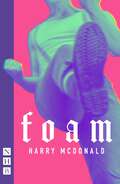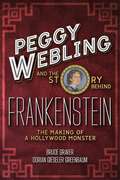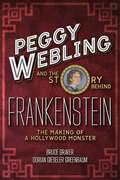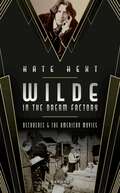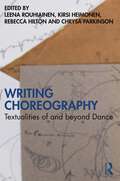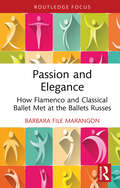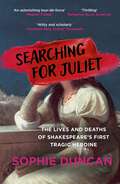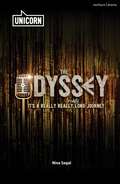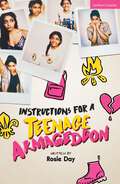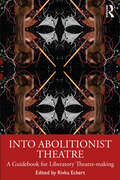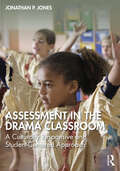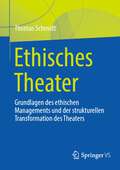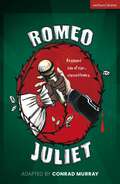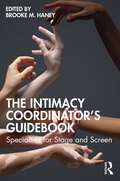- Table View
- List View
Geopolitical Shakespeare: Western Entanglements from Internationalism to Cold War (Oxford Mid-Century Studies Series)
by Erica SheenGeopolitical Shakespeare: Western Entanglements from Internationalism to Cold War examines the entanglement of Shakespearean culture in the geopolitical dynamics of the post-war West. Taking its cue from a speech given by Albert Einstein in London in 1933, in which Shakespeare is cited as an example of the Western value of personal and intellectual freedom, this book explores a series of events between 1945 and 1955 featuring key historical figures--scientists, international lawyers, diplomats and politicians, writers, actors, and filmmakers--who experienced the tensions of the early Cold War through Shakespeare, or called on him to articulate this new post-war world. Erica Sheen examines political, diplomatic, cultural, and economic interactions within 'core' Western power relations--the USA, UK, and Europe, with particular reference to Germany--in which Shakespeare, or the idea of Shakespeare, was entangled in the struggle for new ideas and social structures. The subjects of this book include John Humphrey and the drafting of the Universal Declaration of Human Rights; the Nuremberg Trials and the foundation of West Germany; Noel Annan and the Berlin Elizabethan Festival; an American production of Hamlet in Elsinore; Laurence Olivier, David Selznick, and the Shakespeare film in post-war Hollywood; Graham Greene and The Third Man; and Carl Schmitt and Salvador de Madariaga on Hamlet in post-war Europe. In each of these case studies, Sheen discovers a Shakespeare for our time: engaged in contestations of territoriality in cultures of international law and human rights, theatre, film, and literature.
Geopolitical Shakespeare: Western Entanglements from Internationalism to Cold War (Oxford Mid-Century Studies Series)
by Erica SheenGeopolitical Shakespeare: Western Entanglements from Internationalism to Cold War examines the entanglement of Shakespearean culture in the geopolitical dynamics of the post-war West. Taking its cue from a speech given by Albert Einstein in London in 1933, in which Shakespeare is cited as an example of the Western value of personal and intellectual freedom, this book explores a series of events between 1945 and 1955 featuring key historical figures--scientists, international lawyers, diplomats and politicians, writers, actors, and filmmakers--who experienced the tensions of the early Cold War through Shakespeare, or called on him to articulate this new post-war world. Erica Sheen examines political, diplomatic, cultural, and economic interactions within 'core' Western power relations--the USA, UK, and Europe, with particular reference to Germany--in which Shakespeare, or the idea of Shakespeare, was entangled in the struggle for new ideas and social structures. The subjects of this book include John Humphrey and the drafting of the Universal Declaration of Human Rights; the Nuremberg Trials and the foundation of West Germany; Noel Annan and the Berlin Elizabethan Festival; an American production of Hamlet in Elsinore; Laurence Olivier, David Selznick, and the Shakespeare film in post-war Hollywood; Graham Greene and The Third Man; and Carl Schmitt and Salvador de Madariaga on Hamlet in post-war Europe. In each of these case studies, Sheen discovers a Shakespeare for our time: engaged in contestations of territoriality in cultures of international law and human rights, theatre, film, and literature.
Teaching Shakespeare Beyond the Major
by M. Tyler Sasser Emma K. AtwoodThis edited collection considers the task of teaching Shakespeare in general education college courses, a task which is often considered obligatory, perfunctory, and ancillary to a professor’s primary goals of research and upper-level teaching. The contributors apply a variety of pedagogical strategies for teaching general education students who are often freshmen or sophomores, non-majors, and/or non-traditional students. Offering instructors practical classroom approaches to Shakespeare’s language, performance, and critical theory, the essays in this collection explicitly address the unique pedagogical situations of today’s general education college classroom.
Marina Carr and Greek Tragedy: Feminist Myths of Monstrosity (Routledge Studies in Irish Literature)
by Salomé PaulMarina Carr and Greek Tragedy examines the feminist transposition of Greek tragedy in the theatre of the contemporary Irish dramatist Marina Carr. Through a comparison of the plays based on classical drama with their ancient models, it investigates Carr’s transformation not only of the narrative but also of the form of Greek tragedy. As a religious and political institution of the 5th-century Athenian democracy, tragedy endorsed the sexist oppression of women. Indeed, the construction of female characters in Greek tragedy was entirely disconnected from the experience of womanhood lived by real women in order to embody the patriarchal values of Athenian democracy. Whether praised for their passivity or demonized for showing unnatural agency and subjectivity, women in Greek tragedy were conceived to (re)assert the supremacy of men. Carr’s theatre stands in stark opposition to such a purpose. Focusing on women’s struggle to achieve agency and subjectivity in a male-dominated world, her plays show the diversity of experiencing womanhood and sexist oppression in the Republic of Ireland, and the Western societies more generally. Yet, Carr’s enduring conversation with the classics in her theatre demonstrates the feminist willingness to alter the founding myths of Western civilisation to advocate for gender equality.
Marina Carr and Greek Tragedy: Feminist Myths of Monstrosity (Routledge Studies in Irish Literature)
by Salomé PaulMarina Carr and Greek Tragedy examines the feminist transposition of Greek tragedy in the theatre of the contemporary Irish dramatist Marina Carr. Through a comparison of the plays based on classical drama with their ancient models, it investigates Carr’s transformation not only of the narrative but also of the form of Greek tragedy. As a religious and political institution of the 5th-century Athenian democracy, tragedy endorsed the sexist oppression of women. Indeed, the construction of female characters in Greek tragedy was entirely disconnected from the experience of womanhood lived by real women in order to embody the patriarchal values of Athenian democracy. Whether praised for their passivity or demonized for showing unnatural agency and subjectivity, women in Greek tragedy were conceived to (re)assert the supremacy of men. Carr’s theatre stands in stark opposition to such a purpose. Focusing on women’s struggle to achieve agency and subjectivity in a male-dominated world, her plays show the diversity of experiencing womanhood and sexist oppression in the Republic of Ireland, and the Western societies more generally. Yet, Carr’s enduring conversation with the classics in her theatre demonstrates the feminist willingness to alter the founding myths of Western civilisation to advocate for gender equality.
Foam (Nhb Modern Plays Ser.)
by Harry McDonald1974, a public lavatory. Nicky shaves his head, watched by an older man. Publicly, Nicky is a skinhead. And a neo-Nazi. But right now, in this place, that doesn't matter. This is not the first man Nicky has met in a public toilet, and he won't be the last… Spanning twenty years and inspired by a true story, Foam examines the nature of identity and the consequences of right-wing extremist ideology against the backdrop of London's skinhead and gay scenes of the 1970s and 1980s. Colliding the terrifyingly personal and the violently political, Harry McDonald's play Foam was first performed at the Finborough Theatre, London, in 2024, directed by Matthew Iliffe.
Peggy Webling and the Story behind Frankenstein: The Making of a Hollywood Monster
by Peggy Webling Dorian Gieseler Greenbaum Professor Bruce GraverThe 1931 Universal Pictures film adaptation of Frankenstein directed by James Whale and starring Boris Karloff as the now iconic Monster claims in its credits to be 'Adapted from the play by Peggy Webling'. Webling's play sought to humanize the creature, was the first stage adaptation to position Frankenstein and his creation as doppelgängers, and offered a feminist perspective on scientific efforts to create life without women, ideas that suffuse today's perceptions of Frankenstein's monster. The original play script exists in several different versions, only two of which have ever been consulted by scholars; no version has ever been published. Nor have scholars had access to Webling's private papers and correspondence, preserved in a family archive, so that the evolution of Frankenstein from book to stage to screen has never been fully charted. In Peggy Webling and the Story behind Frankenstein, Dorian Gieseler Greenbaum (Webling's great grandniece) and Bruce Graver present the full texts of Webling's unpublished play for the first time. A vital critical edition, this book includes: - the 1927 British Library Frankenstein script used for the first production of the play in Preston, Lancashire - the 1928 Frankenstein script in the Library of Congress, used for productions in UK provincial theatres from autumn 1928 till 1930 - the 1930 Frankenstein Prompt Script for the London production and later provincial performances, held by the Westminster Archive, London - Webling's private correspondence including negotiations with theatre managers and Universal Pictures, family letters about the writing and production process, and selected contracts - Text of the chapter 'Frankenstein' from Webling's unpublished literary memoir, The Story of a Pen for additional context - Biography of Webling that bears directly on the sensibilities and skills she brought to the writing of her play - History of how the play came to be written and produced - The relationship of Webling's play to earlier stage and film adaptations - An exploration of playwright and screenwriter John L. Balderston's changes to Webling's play and Whale's borrowings from it in the 1931 film Offering a new perspective on the genesis of the Frankenstein movie, this critical exploration makes available a unique and necessary 'missing link' in the novel's otherwise well-documented transmedia cultural history.
Peggy Webling and the Story behind Frankenstein: The Making of a Hollywood Monster
by Peggy Webling Dorian Gieseler Greenbaum Professor Bruce GraverThe 1931 Universal Pictures film adaptation of Frankenstein directed by James Whale and starring Boris Karloff as the now iconic Monster claims in its credits to be 'Adapted from the play by Peggy Webling'. Webling's play sought to humanize the creature, was the first stage adaptation to position Frankenstein and his creation as doppelgängers, and offered a feminist perspective on scientific efforts to create life without women, ideas that suffuse today's perceptions of Frankenstein's monster. The original play script exists in several different versions, only two of which have ever been consulted by scholars; no version has ever been published. Nor have scholars had access to Webling's private papers and correspondence, preserved in a family archive, so that the evolution of Frankenstein from book to stage to screen has never been fully charted. In Peggy Webling and the Story behind Frankenstein, Dorian Gieseler Greenbaum (Webling's great grandniece) and Bruce Graver present the full texts of Webling's unpublished play for the first time. A vital critical edition, this book includes: - the 1927 British Library Frankenstein script used for the first production of the play in Preston, Lancashire - the 1928 Frankenstein script in the Library of Congress, used for productions in UK provincial theatres from autumn 1928 till 1930 - the 1930 Frankenstein Prompt Script for the London production and later provincial performances, held by the Westminster Archive, London - Webling's private correspondence including negotiations with theatre managers and Universal Pictures, family letters about the writing and production process, and selected contracts - Text of the chapter 'Frankenstein' from Webling's unpublished literary memoir, The Story of a Pen for additional context - Biography of Webling that bears directly on the sensibilities and skills she brought to the writing of her play - History of how the play came to be written and produced - The relationship of Webling's play to earlier stage and film adaptations - An exploration of playwright and screenwriter John L. Balderston's changes to Webling's play and Whale's borrowings from it in the 1931 film Offering a new perspective on the genesis of the Frankenstein movie, this critical exploration makes available a unique and necessary 'missing link' in the novel's otherwise well-documented transmedia cultural history.
Wilde in the Dream Factory: Decadence and the American Movies
by Kate HextHollywood is haunted by the ghost of playwright and novelist Oscar Wilde. This is the story of his haunting, told for the first time. Set within the rich evolving context of how the American entertainment industry became cinema, and how cinema become the movies, it reveals how Wilde helped to shape Hollywood in the early twentieth century. It begins with his 1882 American tour, and traces the ongoing popularity of his plays and novel in the early twentieth century, after his ignominious death. Following the early filmmakers, writers and actors as they headed West in the Hollywood boom, it uncovers how and why they took Wilde's spirit with them. There, in Hollywood, in the early days of silent cinema, Wilde's works were adapted. They were also beginning to define a new kind of style -- a 'Wilde-ish spirit', as Ernst Lubitsch called it -- filtering into the imaginations of Lubitsch himself, as well as Alla Nazimova, Ben Hecht, Samuel Hoffenstein and many others. These were the people who translated Wilde's queer playfulness into the creation of screwball comedies, gangster movies, B-movie horrors, and films noir. There, Wilde and his style embodied a spirit of rebellion and naughtiness, providing a blue-print for the charismatic cinematic criminal and screwball talk onscreen. Discussing films including Bringing Up Baby, Underworld, and Laura, alongside definitive adaptations of Wilde's works, including, The Picture of Dorian Gray, Lady Windermere's Fan, and Salome, Wilde in the Dream Factory revises how we understand both Wilde's afterlife and cinema's beginnings.
Writing Choreography: Textualities of and beyond Dance
by Leena Rouhiainen Kirsi Heimonen Rebecca Hilton Chrysa ParkinsonA new contribution to studies in choreography, Writing Choreography: Textualities of and beyond Dance focuses upon language and writing-based approaches to choreographing from the perspectives of artists and researchers active in the Nordic and Oceanic contexts.Through the contributions of 15 dance–artists, choreographers, dramaturges, writers, interdisciplinary artists and artist–researchers, the volume highlights diverse textual choreographic processes and outcomes arguing for their relevance to present-day practices of expanded choreography. The anthology introduces some Western trends related to utilizing writing, text and language in choreographic processes. In its focus on art-making processes, it likewise offers insight into how performance can be transcribed into writing, how practices of writing choreograph and how choreography can be a process of writing with. Readers, such as dancers, choreographers, students in higher education of these fields as well as researchers in choreography, gain understanding about different experimental forms of writing forwarded by diverse choreographers and how writing is the motional organisation of images, signs, words and texts. The volume presents a new strand in expanded choreography and acts as inspiration for its continued evolution that engenders new adaptations between language, writing and choreography.Ideal for students, scholars and researchers of choreography and dance studies.
Writing Choreography: Textualities of and beyond Dance
by Leena Rouhiainen Kirsi Heimonen Rebecca Hilton Chrysa ParkinsonA new contribution to studies in choreography, Writing Choreography: Textualities of and beyond Dance focuses upon language and writing-based approaches to choreographing from the perspectives of artists and researchers active in the Nordic and Oceanic contexts.Through the contributions of 15 dance–artists, choreographers, dramaturges, writers, interdisciplinary artists and artist–researchers, the volume highlights diverse textual choreographic processes and outcomes arguing for their relevance to present-day practices of expanded choreography. The anthology introduces some Western trends related to utilizing writing, text and language in choreographic processes. In its focus on art-making processes, it likewise offers insight into how performance can be transcribed into writing, how practices of writing choreograph and how choreography can be a process of writing with. Readers, such as dancers, choreographers, students in higher education of these fields as well as researchers in choreography, gain understanding about different experimental forms of writing forwarded by diverse choreographers and how writing is the motional organisation of images, signs, words and texts. The volume presents a new strand in expanded choreography and acts as inspiration for its continued evolution that engenders new adaptations between language, writing and choreography.Ideal for students, scholars and researchers of choreography and dance studies.
Passion and Elegance: How Flamenco and Classical Ballet Met at the Ballets Russes (ISSN)
by Barbara File MarangonThis book commences with the history of Indian, Egyptian, Arab, and flamenco dance, then compares and contrasts the history of both classical ballet and flamenco.The book outlines the early roots of flamenco in India, and the journey of the Romani through the Middle East and Europe up to their final destination in Spain. Alongside this, the history of classical ballet is detailed from its beginning in Italy to its later development in France. The book spans the period from the temples of India to Massine’s Spanish ballet, The Three-cornered Hat, for the Ballets Russes. The chronicle of flamenco's journey from India to Spain is important to understanding the development of classical ballet as it relates to The Three-cornered Hat, which is the culmination of the story. The evolution of costumes, space, scenery, and props is examined along with the historical parallels.This exploration is set to inspire and encourage choreographers to partner other dance forms with ballet as Leonide Massine did with flamenco in The Three-cornered Hat while also challenging the anthropological idea of the language of dance movement tracing the migration of people.
Passion and Elegance: How Flamenco and Classical Ballet Met at the Ballets Russes (ISSN)
by Barbara File MarangonThis book commences with the history of Indian, Egyptian, Arab, and flamenco dance, then compares and contrasts the history of both classical ballet and flamenco.The book outlines the early roots of flamenco in India, and the journey of the Romani through the Middle East and Europe up to their final destination in Spain. Alongside this, the history of classical ballet is detailed from its beginning in Italy to its later development in France. The book spans the period from the temples of India to Massine’s Spanish ballet, The Three-cornered Hat, for the Ballets Russes. The chronicle of flamenco's journey from India to Spain is important to understanding the development of classical ballet as it relates to The Three-cornered Hat, which is the culmination of the story. The evolution of costumes, space, scenery, and props is examined along with the historical parallels.This exploration is set to inspire and encourage choreographers to partner other dance forms with ballet as Leonide Massine did with flamenco in The Three-cornered Hat while also challenging the anthropological idea of the language of dance movement tracing the migration of people.
Searching for Juliet: The Lives and Deaths of Shakespeare's First Tragic Heroine
by Sophie Duncan'Witty and scholarly'JONATHAN BATE, SUNDAY TELEGRAPH'Thrilling'GUARDIAN'Illuminating . . . as vital and provocative as the character herself'LITERARY REVIEW'Buoyant'TIMES LITERARY SUPPLEMENT'An astonishing tour-de-force'MARION TURNER, author of The Wife of Bath: A BiographyWho is Juliet Capulet?Daughter of VeronaLovestruck TeenagerRomantic IconTragic HeroineRebelSearching for Juliet takes us from the Renaissance origin stories behind Shakespeare's child bride to enslaved people in the Caribbean, Italian fascists in Verona, and real-life lovers in Afghanistan. From the Victorian stage to 1960s cinema, Baz Luhrmann, and beyond. Drawing on rich cultural and historical sources and new research, Sophie Duncan shows us why Juliet is for now, for ever, for everyone.
The Odyssey: (It's a Really Really Really Long Journey) (Plays for Young People)
by Nina SegalIt starts – like many stories – with a man.A man leaving – heard that before?A man going off to find his fortune.A man going off to start a war.Telemachus was just a baby when his dad Odysseus left to fight in the Trojan War. Now he's almost grown he sets off on a quest to find him, even if his mum is not convinced. Luckily he has the muses - and some great tunes - to guide him on his heroic journey.Join Telemachus on an epic adventure through stormy seas and strange lands, filled with mystical creatures, dangerous monsters and enchanting sirens - plus two talking sheep - and discover what really makes a true hero.This fun, musical re-telling of Homer's classic story The Odyssey is adapted by Nina Segal, with the original production directed by Jennifer Tang.This edition was published to coincide with the world premiere at Unicorn Theatre in London, in March 2024.
The Odyssey: (It's a Really Really Really Long Journey) (Plays for Young People)
by Nina SegalIt starts – like many stories – with a man.A man leaving – heard that before?A man going off to find his fortune.A man going off to start a war.Telemachus was just a baby when his dad Odysseus left to fight in the Trojan War. Now he's almost grown he sets off on a quest to find him, even if his mum is not convinced. Luckily he has the muses - and some great tunes - to guide him on his heroic journey.Join Telemachus on an epic adventure through stormy seas and strange lands, filled with mystical creatures, dangerous monsters and enchanting sirens - plus two talking sheep - and discover what really makes a true hero.This fun, musical re-telling of Homer's classic story The Odyssey is adapted by Nina Segal, with the original production directed by Jennifer Tang.This edition was published to coincide with the world premiere at Unicorn Theatre in London, in March 2024.
Instructions for a Teenage Armageddon (Modern Plays)
by Rosie DayAnd I think you can tell a lot about a person by what they choose to see in you.She was a 17 year old girl; the only God she believed in was Taylor Swift.After her sister's untimely death by a Yorkshire Pudding, a funny teenage misfit begrudgingly joins a flailing scout group to help her navigate the kicks and punches of adolescence with varying degrees of success.Rosie Day's debut play Instructions for a Teenage Armageddon is a rollercoaster ride through youth. Whether you are a young person, know a young person, or simply were a young person once – it's time to rip up the rule book and reconnect with your younger self.This edition was published to coincide with the production which opened at the West End's Garrick Theatre in March 2024.
Instructions for a Teenage Armageddon (Modern Plays)
by Rosie DayAnd I think you can tell a lot about a person by what they choose to see in you.She was a 17 year old girl; the only God she believed in was Taylor Swift.After her sister's untimely death by a Yorkshire Pudding, a funny teenage misfit begrudgingly joins a flailing scout group to help her navigate the kicks and punches of adolescence with varying degrees of success.Rosie Day's debut play Instructions for a Teenage Armageddon is a rollercoaster ride through youth. Whether you are a young person, know a young person, or simply were a young person once – it's time to rip up the rule book and reconnect with your younger self.This edition was published to coincide with the production which opened at the West End's Garrick Theatre in March 2024.
Into Abolitionist Theatre: A Guidebook for Liberatory Theatre-making
by Rivka EckertSeeking to transform community-based theatre-making, this book explores the transformative potential of abolitionist theatre, as theatre artists and teachers collaborate with marginalized communities to challenge systems of oppression and inspire profound societal change.Focusing on the idea of bringing people together to demand collective care and community-led practice, this collection works to define theatre’s role in the goals of abolition. Abolitionist theatre-making is a theatre that is connected to the practice of decolonization, intersectional feminism, climate justice, social justice, and liberation struggles. Exploring these ideas and offering a direct exploration of the questions that theatre artists and teachers should ask themselves when evaluating the abolitionist impact of their work, the volume provides accessible and practical tools for theatre-makers with perspectives from working practitioners throughout. Through real-life stories and experiences shared by theatre practitioners, the book provides a rich and diverse tapestry of examples that highlight the ways in which community-based theatre can contribute to transformational change. Readers will benefit from practical frameworks, thought-provoking perspectives, and thoughtfully crafted insights that inspire them to reimagine their own theatre practices and empower them to create theatre that challenges and dismantles oppressive systems while uplifting marginalized voices.Ideal for undergraduate and graduate students with an interest in utilizing theatre-making for social change, this book offers new and practical insights into how the path to abolition might be laid and theatre’s key role in it. This book will also be of great interest to theatre artists and activist practitioners who are involved in community-based theatre projects with marginalized populations.
Into Abolitionist Theatre: A Guidebook for Liberatory Theatre-making
Seeking to transform community-based theatre-making, this book explores the transformative potential of abolitionist theatre, as theatre artists and teachers collaborate with marginalized communities to challenge systems of oppression and inspire profound societal change.Focusing on the idea of bringing people together to demand collective care and community-led practice, this collection works to define theatre’s role in the goals of abolition. Abolitionist theatre-making is a theatre that is connected to the practice of decolonization, intersectional feminism, climate justice, social justice, and liberation struggles. Exploring these ideas and offering a direct exploration of the questions that theatre artists and teachers should ask themselves when evaluating the abolitionist impact of their work, the volume provides accessible and practical tools for theatre-makers with perspectives from working practitioners throughout. Through real-life stories and experiences shared by theatre practitioners, the book provides a rich and diverse tapestry of examples that highlight the ways in which community-based theatre can contribute to transformational change. Readers will benefit from practical frameworks, thought-provoking perspectives, and thoughtfully crafted insights that inspire them to reimagine their own theatre practices and empower them to create theatre that challenges and dismantles oppressive systems while uplifting marginalized voices.Ideal for undergraduate and graduate students with an interest in utilizing theatre-making for social change, this book offers new and practical insights into how the path to abolition might be laid and theatre’s key role in it. This book will also be of great interest to theatre artists and activist practitioners who are involved in community-based theatre projects with marginalized populations.
Assessment in the Drama Classroom: A Culturally Responsive and Student-Centered Approach
by Jonathan P. JonesThis textbook offers a practical approach for designing and implementing assessment for learning in the drama classroom.Assessment in the Drama Classroom begins with a theoretical overview that covers the purpose of assessment with student-centered, culturally responsive methods. The following chapters present an in-depth analysis of how to organize drama curriculum, develop measurable learning objectives, and implement a backward planning approach to summative assessment. Models and tools for generating diagnostic, formative, and summative assessments for various grade levels invite the reader to adapt these approaches to their classrooms.Ideal for drama education and pedagogy courses, this book is an accessible tool for drama educators to engage in critical reflection on assessment. Drama educators will find methods and suggestions for reimagining their assessment practices and be empowered to meet the learning needs of their students.
Ethisches Theater: Grundlagen des ethischen Managements und der strukturellen Transformation des Theaters
by Thomas SchmidtMit dem Konzept des Ethischen Theaters wird ein ganzheitliches Zukunftsmodell vorgestellt. Ausgangspunkt ist die Analyse der gegenwärtigen Krisen und der Komplexität in den deutschsprachigen Theatern, um die Grundlagen für ihren Transformationsprozess zu entwickeln. Mit dem Ethischen Theater wird ein Ziel dieses Prozesses vorgestellt: das ganzheitliches Zukunftsmodell einer Theater-Organisation des 21. Jahrhunderts, in der ethische Überlegungen erstmals in allen Prozessen handlungsleitend sind. Das Modell ist kompatibel mit den Interessen der Stakeholder und den wichtigen Reformprozessen, es ermöglicht die anstehende strukturelle Modernisierung der Theaterbetriebe. Unterstützt wird es durch das Konzept des Ethischen Theatermanagements, das erstmals über die klassischen Funktionen hinaus auch Aspekte der Diversität, der Nachhaltigkeit, der Ethik und der Zukunftsfähigkeit adressiert. Mit den erweiterten Funktionen des ethischen Managements werden auch weitere Möglichkeitsräume für die Zukunft der Kultur-Organisationen eröffnet.
Romeo and Juliet (Plays for Young People)
by Conrad MurrayTwo Postcodes, two streets apartIn dear Merton where our story starts.Beef from the past creates new tension.Innocent blood spilled they need an intervention.A boy and a girl, supposed to be ops;They chat, hold hands, secret meetings by the shops.A remixed tale of star-crossed lovers.How much would you risk for the person you love?Forced apart by generations of hatred, young eyes meet across a South London dancefloor on a fateful night that will change their lives forever. Shakespeare's most famous story is re-told through rap, rhythms, and beautiful harmonies. It's Romeo and Juliet, but as you've never heard it before. Put down your swords and pick up your mics, after all, the course of true love never did run smooth.From Conrad Murray, the creator behind the 2023 Offie award-winning Pied Piper: The Hip Hop Family Musical, with contributions from Lakeisha Lynch-Stevens, Khai Shaw, and Kate Donnachie.This edition was published to coincide with the world premiere at London's Polka Theatre in March 2024.
Romeo and Juliet (Plays for Young People)
by Conrad MurrayTwo Postcodes, two streets apartIn dear Merton where our story starts.Beef from the past creates new tension.Innocent blood spilled they need an intervention.A boy and a girl, supposed to be ops;They chat, hold hands, secret meetings by the shops.A remixed tale of star-crossed lovers.How much would you risk for the person you love?Forced apart by generations of hatred, young eyes meet across a South London dancefloor on a fateful night that will change their lives forever. Shakespeare's most famous story is re-told through rap, rhythms, and beautiful harmonies. It's Romeo and Juliet, but as you've never heard it before. Put down your swords and pick up your mics, after all, the course of true love never did run smooth.From Conrad Murray, the creator behind the 2023 Offie award-winning Pied Piper: The Hip Hop Family Musical, with contributions from Lakeisha Lynch-Stevens, Khai Shaw, and Kate Donnachie.This edition was published to coincide with the world premiere at London's Polka Theatre in March 2024.
The Intimacy Coordinator's Guidebook: Specialties for Stage and Screen
The Intimacy Coordinator's Guidebook: Specialties for Stage and Screen explores the role of the intimacy choreographer with an in-depth look at specializations that exist within the profession.With contributions by over 30 industry professionals, this book aims to bring awareness to a wide range of needs a project may have and how intimacy professionals use their cultural competency specialists in practice to create the most compelling storytelling. In Part One, the book addresses the scope of practice of an intimacy professional by discussing competency, finding your lens and tangential fields in the industry like fight directors, mental health coordinators and cultural competency specialists. Part Two covers specialties like working with minors, prosthetics, intimacy and disability, staging queer intimacy, working with fat actors, Black American intimacy, dance, working on scenes of trauma, sexual violence and non-consent, and BDSM. Between each chapter is a conversation with an actor, director or producer on their experiences working with an intimacy coordinator. In Part Three, the book looks at what it means to be qualified and intimacy professionals' hopes for the future of the industry.The Intimacy Coordinator's Guidebook is an invaluable resource for directors and producers looking to hire an intimacy professional, as well as in-depth study for those who are training or practicing in the field of intimacy for performance.
